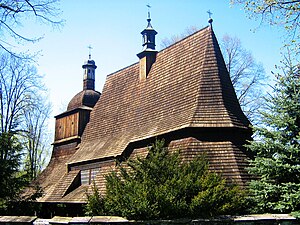Wooden Churches of Southern Little Poland
| Wooden Churches of Southern Lesser Poland |
|
|---|---|
| Name as inscribed on the World Heritage List | |
 |
|
| Location | Poland |
| Type | Cultural |
| Criteria | iii, iv |
| Reference | 1053 |
| UNESCO region | Europe |
| Inscription history | |
| Inscription | 2003 (27th Session) |
Wooden Churches of Southern Lesser Poland and Subcarpathia of the UNESCO inscription are located in Gorlice, Nowy Targ, Bochnia counties (Lesser Poland Voivodeship or Małopolskie), and Brzozów County (Subcarpathian Voivodeship) and are in Binarowa, Blizne, Dębno, Haczów, Lipnica Dolna, and Sękowa. There are in fact many others of the region which fit the description: "The wooden churches of southern Little Poland represent outstanding examples of the different aspects of medieval church-building traditions in Roman Catholic culture. Built using the horizontal log technique, common in eastern and northern Europe since the Middle Ages..."
The wooden church style of the region originated in the late Medieval, the late sixteenth century, and began with Gothic ornament and polychrome detail, but because they were timber construction, the structure, general form, and feeling is entirely different from the gothic architecture or Polish Gothic (in stone or brick). Later construction show Rococo and Baroque ornamental influence. The form of these Roman Catholic churches is deeply influenced by the Greco-Catholic and Orthodox presence in the region. Some display Greek cross plans and onion domes, but the most interesting of the churches combine these features with the Roman forms with elongated naves and steeples. Other collections of wooden churches of the region are in the open-air museums in Sanok and Nowy Sącz.
...
Wikipedia

